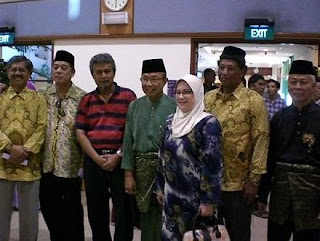Today, 11th Dzulhijjah, four years ago, I was in Mina, celebrating Eid-ul-Adha with my husband and son. It was the year I performed Hajj, the fifth pillar of Islam. The Hajj pilgrimage was the most amazing experience in my life, leaving me with unforgettable memories and valuable lessons, teaching me the meaning of life through real encounters. TsuMina, the big flood in Mina, left me with a remarkable memory of my 2005 Hajj pilgrimage. Mina, a low lying area just outside Makkah, is a valley surrounded by mountains. It is part of the Hajj ritual to be at Mina in order to perform the stoning of the Jamrah. Jamrah are three pillars built to signify the incident that took place long ago during the lifetime of Prophet Abraham a.s. whereby Satan tried three times to stop him from having his son, Ishmael a.s., to be sacrificed.
The flood happened on the third day of my stay at Mina. It was after lunch that I noticed the sky was not as sunny as the previous two days and it was rather windy. I was attending to my son, entertaining him with a little touring around the campsite. It was a wonderful breezy day. Just minutes before Asar, I brought my son to the toilet area to have him showered. He was happy to have his shower done and eager to get back to the camp. While walking towards Hahnemann’s camp against the developing strong wind, I noticed the grey sky and soon droplets of water fell from the sky. By the time I reached the camp, it was raining heavily.
The rain grew heavier and pools of water were forming outside along the walk-way. I quickly gathered my belongings, put on my shoes, and carried my son. Soon I could see sandals outside the camp being washed down the slope. I was already standing with my handbag full of medicine on one shoulder, carrying one luggage bag in one hand and holding my son in the other when water began rushing into the camp. In about less than ten minutes, the water level was up to my knee. I was terrified but remained calm nonetheless. I looked up at the steel poles that were holding up the camp. They were putting up a weak resistance, swaying with the strong wind. I looked on, worried and anxious for my husband’s presence to help me get out of the camp to safety.
Finally when my husband came, we hurriedly left the camp in search for higher ground. By then, the water was already level to my waist. We walked in the heavy rain, shivering in the cold for about ten minutes before entering into another camp. The camp had an entrance leading us to the campsite's toilet area that was situated on a higher ground. We then took shelter in one of the cubicles until the rain stopped. That night we slept in the camp which was left empty by the Bruneians who moved on to Makkah to complete their Hajj rituals. Our Hajj package operator, Hahnemann Travel and Tours Private Limited, was very responsible. The safety and well-being of its Jema’ah as well as their intention in completing the Hajj rituals were its priority. We felt grateful to Hahnemann Travel for instructing its Hajj pilgrims to stay at Mina to complete the stoning of the Jamrah.
That night, I could not sleep much and pondered on what had happened. The flood was a warning as well as a blessing to me. I felt that Almighty Allah had pardoned me and given His mercy by fulfilling my wish of wanting to perform the stoning of the Jamrah easily for the sake of my son, who was then two years nine months. Unlike the first two days of my stay, the stoning area was rather deserted as there were very little people performing the ritual after the flood. Indeed, the flood in Mina was a test of faith, testing my trust in Almighty Allah in a time of difficulty in which my unrelenting faith was rewarded with easy stoning of the three Jamrah.
Al-Hamdulillah, this incident enabled me to see the beauty of Islam and the significance of Hajj. From it, I learned that I was given the opportunity to experience receiving the reward for having and putting faith in Almighty Allah (Allah is an Arabic word for God), trusting Him as the only Protector, the only One with the ability to save anybody from everything and anything. Indeed, nothing escapes Allah’s will and all is possible except Allah the Most High -with Allah, everything is possible, no one can imitate Allah's creations, and there is only one God.


























































